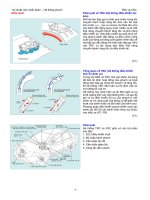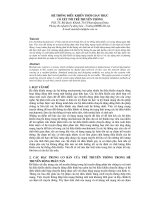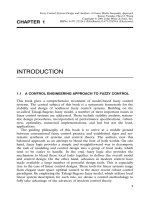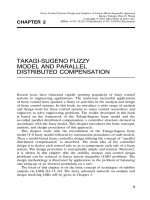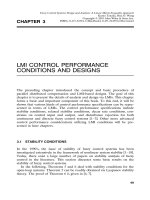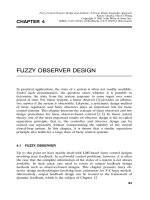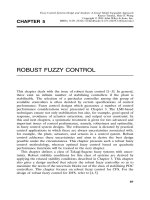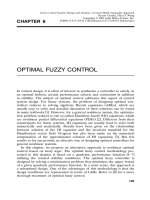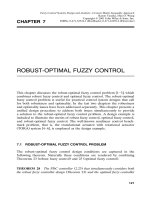Tài liệu Hệ thống điều khiển mờ - Thiết kế và phân tích P5 pdf
Bạn đang xem bản rút gọn của tài liệu. Xem và tải ngay bản đầy đủ của tài liệu tại đây (138.13 KB, 12 trang )
Fuzzy Control Systems Design and Analysis: A Linear Matrix Inequality Approach
Kazuo Tanaka, Hua O. Wang
Copyright ᮊ 2001 John Wiley & Sons, Inc.
Ž. Ž .
ISBNs: 0-471-32324-1 Hardback ; 0-471-22459-6 Electronic
CHAPTER 5
ROBUST FUZZY CONTROL
wx
This chapter deals with the issue of robust fuzzy control 1᎐3. In general,
there exist an infinite number of stabilizing controllers if the plant is
stabilizable. The selection of a particular controller among this group of
available controllers is often decided by certain specifications of control
performance. Fuzzy control designs which guarantee a number of control
performance considerations were presented in Chapter 3. The LMI-based
techniques ensure not only stabilization but also, for example, good speed of
response, avoidance of actuator saturation, and output error constraint. In
this and next chapters, a systematic treatment is given for two advanced and
important issues of control performance, namely, robustness and optimality,
in fuzzy control system designs. The robustness issue is dictated by practical
control applications in which there are always uncertainties associated with,
for example, the plant, actuators, and sensors in a control system. Robust
control addresses these uncertainties and aims to derive the best design
possible under the circumstances. This chapter presents such a robust fuzzy
control methodology, whereas optimal fuzzy control based on quadratic
performance functions will be treated in the next chapter.
This chapter defines a class of Takagi-Sugeno fuzzy systems with uncer-
tainty. Robust stability conditions for this class of systems are derived by
applying the relaxed stability conditions described in Chapter 3. This chapter
also gives a design method that selects the robust fuzzy controller so as to
maximize the norm of the uncertain blocks out of the class of stabilizing PDC
controllers. This chapter focuses on robust fuzzy control for CFS. For the
wx
design of robust fuzzy control for DFS, refer to 4, 5 .
97
ROBUST FUZZY CONTROL
98
5.1 FUZZY MODEL WITH UNCERTAINTY
To address the robustness of fuzzy control systems, a first and necessary step
is to introduce a class of fuzzy systems with uncertainty. For this purpose, we
introduce uncertainty blocks to the Takagi-Sugeno fuzzy model to arrive at
the following fuzzy model with uncertainty:
Plant Rule i
Ž. Ž.
IF ztis M and иии and ztis M
1 i1 pip
Ž. Ž Ž. . Ž.
THEN xt s A q D ⌬ t Ext
˙
iaiaiai
ŽŽ..Ž.
q B q D ⌬ t Eut , i s 1,2,...,r,5.1
Ž.
ibibibi
where the uncertain blocks satisfy
1
⌬ t F ,5.2
Ž. Ž .
ai
␥
ai
⌬ t s ⌬
T
t ,5.3
Ž. Ž. Ž .
ai ai
1
⌬ t F ,5.4
Ž. Ž .
bi
␥
bi
⌬ t s ⌬
T
t 5.5
Ž. Ž. Ž .
bi bi
for all i. The fuzzy model is represented as
r
x t s h z t A q D ⌬ t Ext
Ä
Ž. Ž. Ž. Ž.
Ž.
Ž.
˙
Ý
i i ai ai ai
i
s1
q B q D ⌬ t Eut .5.6
4
Ž. Ž. Ž .
Ž.
ibibibi
Ž.w Ž.x
The fuzzy model 5.1 or 5.6 contains uncertainty in the consequent
parts. The robust stability for the fuzzy model with premise uncertainty was
wx wx
first discussed in 6 and 7 . This chapter will focus on the consequent
uncertainty.
5.2 ROBUST STABILITY CONDITION
To begin with, this section presents a stability condition for the uncertain
Ž.w Ž.x Ž.
fuzzy model 5.1 i.e., 5.6 . By substituting the PDC controller 2.23 into
ROBUST STABILITY CONDITION
99
Ž.
5.6 , we have
rr
x t s h z thz t
Ž. Ž. Ž.
Ž.Ž.
˙
ÝÝ
ij
i
s1 js1
=
E
⌬ 0
ai
ai
DD
A y BFq x t
Ž.
ai bi
iij
½5
yEF
0 ⌬
bi j
bi
r
⌬ 0 E
ai ai
2
DD
s h z t A y BFq x t
Ž. Ž.
Ž.
Ý
ai bi
iiii
½5
0 ⌬ yEF
bi bi i
i
s1
r
q h z thz t
Ž. Ž.
Ž.Ž.
ÝÝ
ij
i
s1 i-j
=
E
⌬ 0
ai
ai
DD
A y BFq A y BFq
ai bi
iijjji
½
yEF
0 ⌬
bi j
bi
⌬ 0 E
aj aj
DD
q x t .5.7
Ž. Ž .
aj bj
5
0 ⌬ yEF
bj bj i
The following theorem presents robust stability conditions for the fuzzy
Ž.w Ž.x Ž.
model 5.1 i.e., 5.6 with a given PDC fuzzy controller 2.23 . This theorem
provides a basis for the robust stabilization problem which is considered in
the next section.
Ž.w Ž.x
THEOREM 22 The fuzzy system 5.1 i.e., 5.6 is stabilized ®ia the PDC
Ž.
controller 2.23 if there exist a common positi®e definite matrix P and a common
positi®e semidefinite matrix Q satisfying
0
S q s y 1 Q - 0,5.8
Ž. Ž.
ii 1
T y 2Q - 0, i - j s.t. h l h /
,5.9
Ž.
ij 2 ij
where s ) 1,
T
TTT
A y BF Pq PAy B F PD PD E yFE
Ž.Ž.
iii iii ai bi ai ibi
T
DP yI 00 0
ai
T
S s ,
DP 0 yI 00
ii
bi
2
E 00y
␥
I 0
ai ai
2
yEF 00 0y
␥
I
bi i bi
ROBUST FUZZY CONTROL
100
T
A
y BF P
Ž.
iij
q
PAy BF
Ž.
iij
TTTTTT
PD PD PD PD E
yFE E yFE
ai bi aj bj ai j bi aj i bj
T
q
A y BF P
Ž.
jji
0
q
PAy BF
Ž.
jji
T
DP
yI 000 0 0 0 0
ai
T
DP
0 yI 00 0 0 0 0
bi
T s
,
ij
T
DP
00yI 00 0 0 0
aj
T
DP
000yI 0000
bj
2
E
0000y
␥
I 000
ai ai
2
y
EF 0000 0y
␥
I 00
bi j bi
2
E
0000 0 0y
␥
I 0
aj aj
2
y
EF 0000 0 0 0y
␥
I
bj i bj
Q 0000
Q s block-diag ,
Ž.
0
1
Q 00000000
Q s block-diag .
Ž.
0
2
Ž.
Proof. Consider the T-S fuzzy control system with uncertainty 5.1 , where
Ž. Ž.
⌬ t and ⌬ t are the uncertain blocks satisfying
ai bi
1
T
⌬ t F , ⌬ t s ⌬ t ,
Ž. Ž. Ž.
ai ai ai
␥
ai
1
T
⌬ t F , ⌬ t s ⌬ t .
Ž. Ž. Ž.
bi bi bi
␥
bi
T
Ž. Ž.
Consider a candidate of Lyapunov functions x t Px t . Then,
d
T
x t Px t
Ž. Ž.
dt
s x
T
t Px t q x
T
t Px t
Ž. Ž. Ž. Ž.
˙˙
T
r
⌬ 0 E
ai ai
2 T
DD
s h z t x t A y BFq P
Ž. Ž.
Ž.
Ý
ai bi
iiii
½
ž/
0 ⌬ yEF
bi bi i
i
s1
⌬ 0 E
ai ai
DD
qPAy BFq x t
Ž.
ai bi
iii
5
ž/
0 ⌬ yEF
bi bi i
ROBUST STABILITY CONDITION
101
r
T
q h z thz t x t
Ž. Ž. Ž.
Ž.Ž.
ÝÝ
ij
i
s1 i-j
T
°
E
⌬ 0
ai
ai
~
DD
= A y BFq P
ai bi
iij
yEF
¢
0 ⌬
ž/
bi j
bi
E
⌬ 0
ai
ai
DD
qPAy BFq
ai bi
iij
yEF
0 ⌬
ž/
bi j
bi
T
⌬ 0 E
aj aj
DD
q A y BFq P
aj bj
jji
0 ⌬ yEF
ž/
bj bj i
¶
⌬ 0 E
aj aj
•
DD
qPAy BFq x t
Ž.
aj bj
jji
ß
0 ⌬ yEF
ž/
bj bj i
r
2 T
s h z t x t
Ž. Ž.
Ž.
Ý
i
i
s1
=
T
D
ai
T
DD
A y BF Pq PAy BF q PP
Ž.Ž.
ai bi
iii iii
T
½
D
bi
T
⌬ 0 ⌬ 0 E
ai ai ai
T
T
q
E y EF
Ž.
ai bi i
0 ⌬ 0 ⌬ yEF
bi bi bi i
T
T
D ⌬ 0 E
ai ai ai
y P y
T
0 ⌬ yEF
ž/
D
bi bi i
bi
T
¶
D ⌬ 0 E
ai ai ai
•
= P y x t
Ž.
T
ß
0 ⌬ yEF
ž/
D
bi bi i
bi
r
T
q h z thz t x t
Ž. Ž. Ž.
Ž.Ž.
ÝÝ
ij
i
s1 i-j
